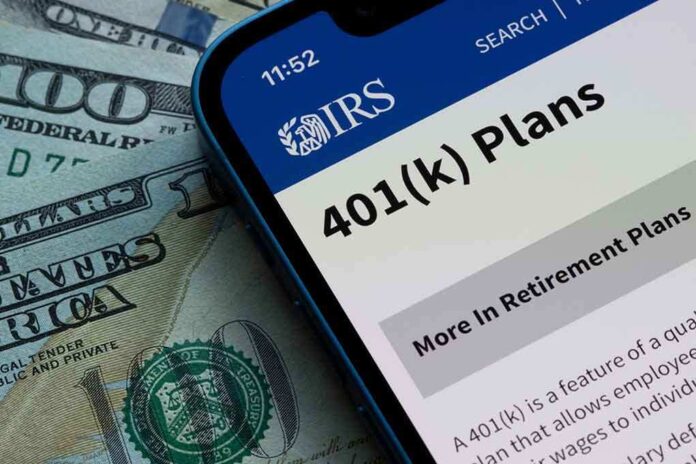
There’s a little-known IRS loophole that lets you raid your 401(k) before age 59½—without paying the dreaded 10% penalty—and the catch is, most Americans have no idea it exists.
Story Snapshot
- The “rule of 55” allows penalty-free 401(k) withdrawals if you leave your job in the year you turn 55 or later.
- This exception applies only to the 401(k) at your most recent employer, not IRAs or previous plans.
- Early access can ease the financial stress of unexpected job loss or planned early retirement.
- Draining funds too soon can jeopardize your long-term retirement security, so strategic planning is essential.
The Rule of 55: IRS Fine Print Most Miss
Most Americans know that 401(k) plans are built for long-term retirement savings, with pre-tax contributions and tax-deferred growth. What they often miss is the IRS’s strict regime: withdrawals before age 59½ typically trigger a 10% penalty plus income tax. But buried in the tax code is the “rule of 55”—if you leave your job in the calendar year you turn 55 or later, you can tap your current employer’s 401(k) penalty-free. This isn’t a hack for IRAs or old 401(k)s; it applies solely to the account from the job you just left.
For example, imagine you’re 57, laid off, and sitting on $400,000 in your 401(k)—you can withdraw funds without a penalty. But try the same with a $150,000 IRA, and you’ll lose 10% off the top. The rule seems tailor-made for those facing an unexpected career curveball or planning to retire a few years early. For many, this is a lifeline, not just a loophole.
Why the IRS Imposes Withdrawal Penalties
The IRS’s penalties aren’t about punishing savers. They exist because early withdrawals can decimate your retirement nest egg. Tax breaks are meant to encourage you to keep your money invested until you’re truly ready to retire. The government is, in effect, protecting you from yourself—if you spend too soon, you could run out just when you need steady income most, especially when Social Security alone may not be enough.
The “rule of 55” exception recognizes real-life scenarios: layoffs, health events, or simply wanting to step away from the grind in your late fifties. It’s a safety valve, but it comes with warnings. Any money you withdraw is still taxed as ordinary income, and the temptation to splurge can leave you dangerously exposed in your seventies.
Strategic Risks of Early Withdrawals
Just because you qualify for penalty-free withdrawals doesn’t mean you should jump in. Drawing down your 401(k) before 59½ can cut years off your savings horizon. Financial experts warn that starting withdrawals at 55 often means sticking to a lower withdrawal rate—sometimes less than the classic 4% rule—just to avoid running out in your later retirement. And with inflation and healthcare costs rising, a hasty decision now can have lifelong consequences.
For those forced out of work in their mid-fifties, gig economy jobs or consulting in your previous field may help bridge the gap, letting your retirement savings continue growing. The flexibility to withdraw is valuable, but it’s a double-edged sword if used without a plan. Financial advisors often urge patience: tap your 401(k) only if you have no other reasonable alternatives.
Smart Moves for the Second Half of Your Fifties
The years between 55 and 59½ are a financial crossroads. If you’re laid off, the “rule of 55” can help you avoid scrambling for any job just to pay the bills. But every dollar withdrawn now means less for later, especially as longevity increases. If you’re not ready to retire, consider part-time work, freelancing, or consulting to preserve your nest egg. For those with enough savings, early access may provide peace of mind—but only if it’s part of a larger plan that weighs taxes, withdrawal rates, and future needs.
The IRS’s early withdrawal exceptions are there to help—not to encourage reckless spending. Tapping your 401(k) early is a decision that should be made with care, calculation, and an eye on the long-term horizon. For many Americans, knowing this rule could mean the difference between a smooth transition and financial strain, but only if wielded with discipline.
Sources:
The Motley Fool: Retirement Plans
The Motley Fool: Social Security Benefits Formula
The Motley Fool: 4 Percent Rule












